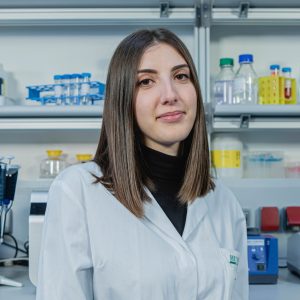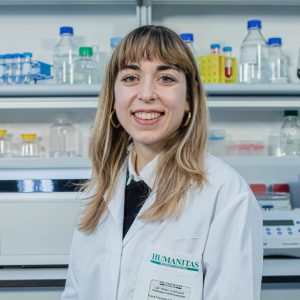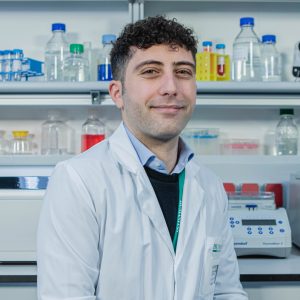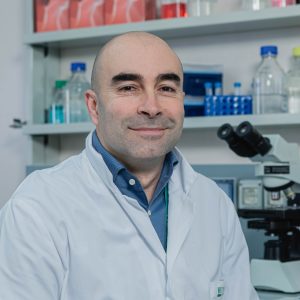Research Group
Rusconi Group
Applied Physics Biophysics & Microfluidics Lab
By combining microfluidics and mathematical modelling, the lab aims at understanding the response of bacterial biofilms to changing environmental conditions, as well as the fluid mechanics of microorganisms and biological systems, with the final goal of hindering microbial colonization and biofilm formation in the clinical setting.
The challenge
Biofilms are bacterial communities embedded in a protective matrix of self-secreted extracellular substances. Since bacteria form biofilms as part of their survival strategy, biofilms are ubiquitous in nature: already in the seventeenth century, the first biofilms were observed and described with rudimentary microscopes. We now know that biofilms are involved in many aspects of human life, representing both beneficial and detrimental effects, and even contribute to the pathogenesis of persistent and chronic infections. In fact, hidden within the biofilm, bacteria adapt to the lack of oxygen and nutrients and in turn become more resistant to therapies and to host defense mechanisms. Understanding biofilm formation and dynamics in different contexts could help us to fight multi-resistant bacteria, considered by the WHO one of the ten global health threats to humanity’s future.
Main research areas
Surface colonization and mechanosensing
Little is known about the mechanistic basis of the effect of flow on bacterial attachment to surfaces. We are studying how the magnitude and location of microbial colonization is governed by the interplay between fluid flow and microbial motility in different types of surfaces. Using microfluidic experiments and numerical modeling, we are also studying how substrates with controlled topographies and surface chemistry affect bacteria colonization.
Biofilm streamers
Streamers are suspended, filamentous bacterial biofilms that often form in a wide range of environments, ranging from catheters and medical implants to tubing and filtration systems. In collaboration with researchers at ETH and the University of Zurich, we recently uncovered the key role of bacterial extracellular DNA in the formation of the streamers by Pseudomonas aeruginosa and other human pathogens, opening up new strategies to counteract streamers development, such as DNA-degrading enzymes.
Device-associated infections
The recalcitrance to conventional antibiotic therapies of biofilms grown on medical devices usually requires revision operations and replacement of the implant, with increased morbidity, mortality, and a devastating impact on the patient’s quality of life. In addition, the spread of multidrug-resistant bacteria is constantly growing, increasing public concern about the health risks for hospitalized patients due to device-associated microbial infections. In collaboration with clinicians at Humanitas Hospital, we are studying the different microbiota compositions that correlate with a particular device and with the presence of mechanical forces. Furthermore, thanks to microfluidics, we are assessing the complex interplay between surface-attached bacteria and the peri-prosthetic microenvironment.
Microfluidic platforms for biomimesis
We are working on the development of biomimetic systems based on microfluidics and microfabrication. Among those: in collaboration with Matteoli Group, a model of the blood-brain barrier (BBB) – that can be used to evaluate the transmigration of leukocytes and the diffusion of drugs; a model of the brain cortex through microfluidics and bioprinting, done in collaboration with Lodato Group and the Polytechnic University of Milan, as well as microfluidic channels mimicking blood flow to investigate the transport and uptake of nanoparticles through the vascular network.
Selected publications
A microfluidic platform for characterizing the structure and rheology of biofilm streamers.
Environmental, Microbiological, and Immunological Features of Bacterial Biofilms Associated with Implanted Medical Devices.
The structural role of bacterial eDNA in the formation of biofilm streamers.
The effect of flow on swimming bacteria controls the initial colonization of curved surfaces.
Not Just Going with the Flow: The Effects of Fluid Flow on Bacteria and Plankton.
Synthesis and degradation of FtsZ quantitatively predict the first cell division in starved bacteria.
Deployable micro-traps to sequester motile bacteria.
Biofilm disruption by an air bubble reveals heterogeneous age-dependent detachment patterns dictated by initial extracellular matrix distribution.
Logarithmic sensing in Bacillus subtilis aerotaxis.
Microfluidic Studies of Biofilm Formation in Dynamic Environments.
Intermittent turbulence in flowing bacterial suspensions.
Microfluidics expanding the frontiers of microbial ecology.
The extracellular matrix Component Psl provides fast-acting antibiotic defense in Pseudomonas aeruginosa biofilms.
Bacterial transport suppressed by fluid shear
Fluid Mechanics of Planktonic Microorganisms
Group members





